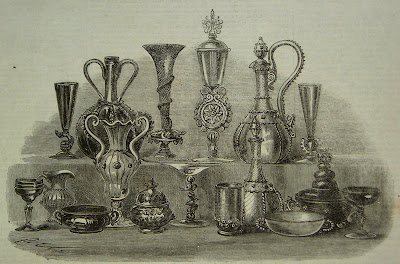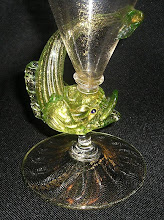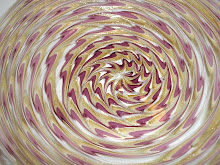[click on photo to enlarge]
Following is the verbatim, partial transcript of the actual article which appeared on December 15, 1866, in THE ILLUSTRATED LONDON NEWS. The portion which we have begins on page 585, although the original beginning and that portion which would complete this article, began on page 584. Mentioned are places of note, in London, where examples of Dr. Salviati's glass mosaics may be seen, presumably today, also. The original address of his London showrooms is also offered. Very interesting historical information is within this article for the serious collector and student of glass. The article reads:
"....an intelligent and experienced artisan of Murano, who had, some years before gained some public notice of his exhibitions of the enameling process. Dr. Salviati, having carefully studied the whole subject, and being a man of science as well as of taste, succeeded in the invention of a new method of mosaic manufacturer, the results of which already are to be seen in England in several fine examples, such as the large picture of Isaiah and the Angels beneath the dome of St. Paul's Cathedral, the vaulted roof and other parts of Cardinal Wolsey's Chapel in Windsor Castle, that prepared for the canopy of the Prince Consort National Memorial in Hyde Park, the cross over the chancel arch of All Saints' Church at Windsor, and a lifesize figure in the South Kensington Museum, besides important works in hand for Westminster Abbey. Dr. Salviati next turned his attention to the blown-glass manufacturer, which is practised in its greatest perfection at Murano, a small island of the Lagoons, near Venice. A minute description of the works at this place was given by the special correspondent of the Times in a letter published on the 19th of last October. The tools used are few and simple, being only the furnace, a hollow reed or tube of iron, a few pairs of shears and cutting instruments, and stamps and dies. The end of the reed is dipped into molten glass; a portion is thus taken up and rolled on the table, after which the blower, with his own breath through the tube, converts it into a hollow ball, and it is shaped by hand, with repeated manipulations, into a drinking-glass, a cup, a jug, a vase, a bowl, a decanter, a chandelier, or whatever else may be designed. The variety of ornamentation, as by filigree-work, interlacing opaque with transparent glass, by intermixture of gold, ruby, green, purple, and other colours, or by moulding and twisting the stems and edges, of which this manufacture is capable, may be witnessed in a visit to Dr. Salviati's London depot, 431, Oxford-street. A few specimens are represented in our Engraving [above] which shows at least the graceful designs of modern Venetian glass."




































No comments:
Post a Comment
Thanks for viewing our blog; your comments are welcome. Please look in often for interesting photos and facts about glass.